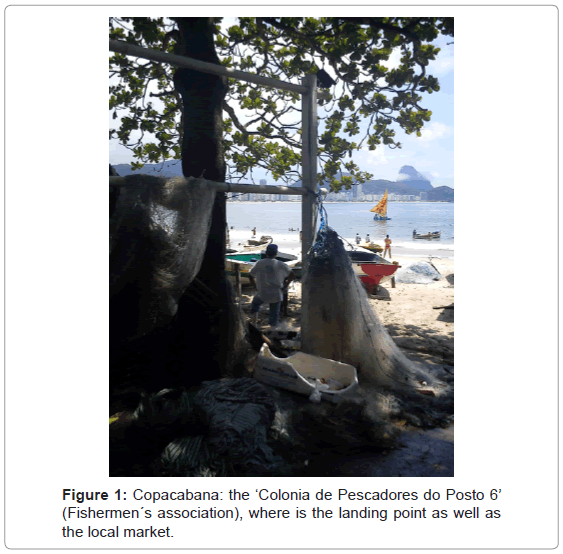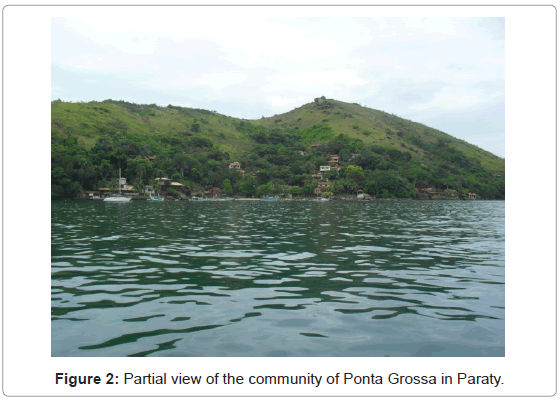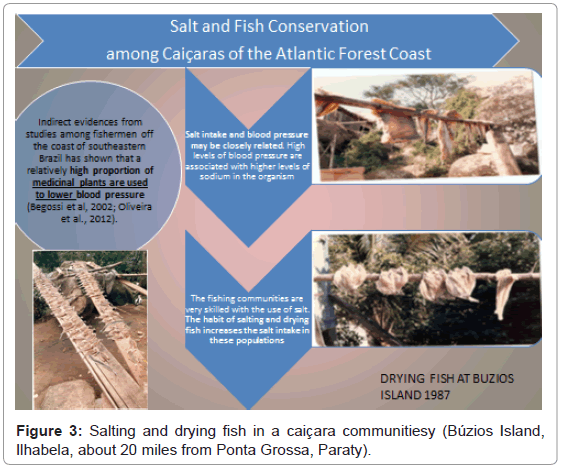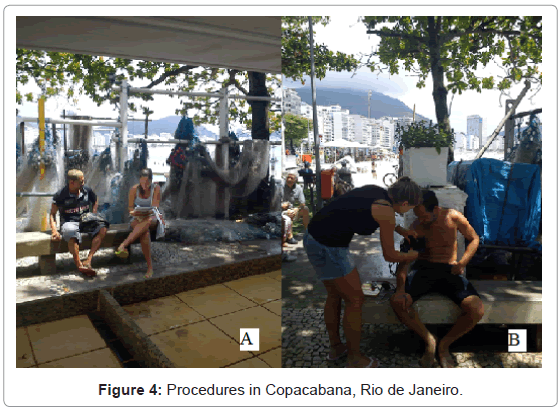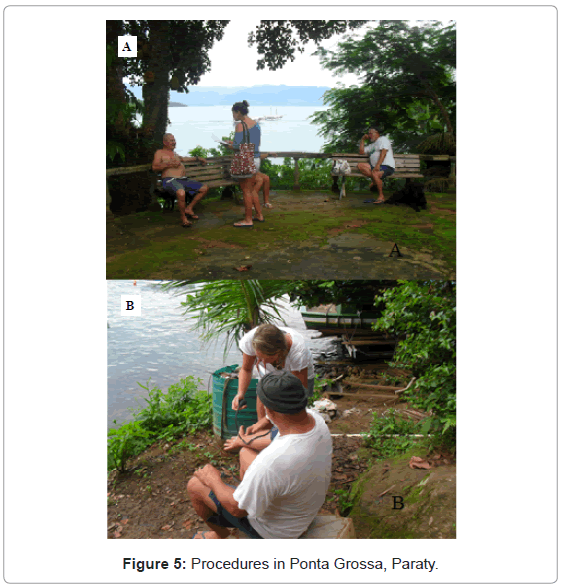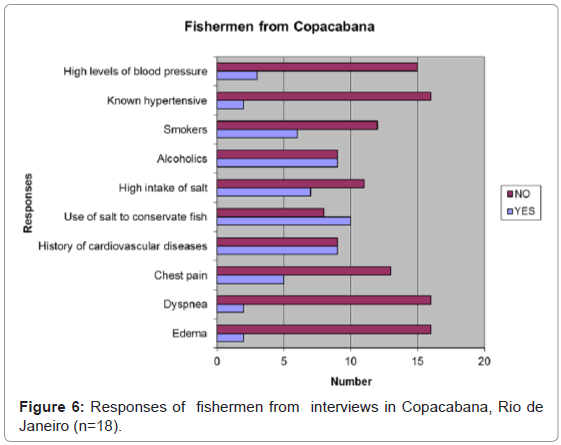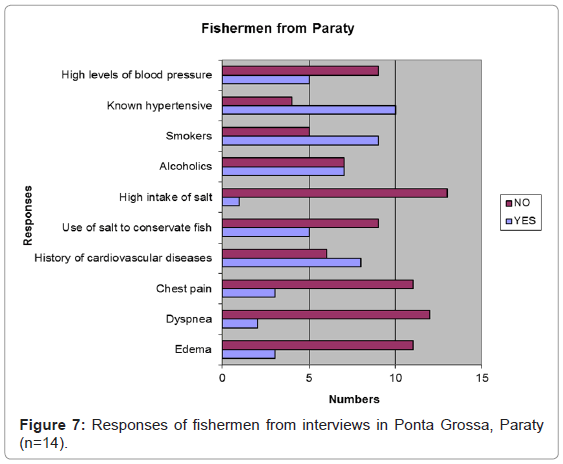Research Article Open Access
Blood Pressure and Hypertension among Coastal Fishermen in South-east Brazil
Mariana Passos Cavichiolo2 Bruna Oliveira Begossi1* Cristina Brandt Friedrich Martin Gurgel31Undergraduated Course of Medicine in PUC-Campinas, Brazil
2Real Sociedade Portuguesa de Beneficiência, Brazil
3Professor Doutora em Clínica Médica do Centro de Ciências da Vida, Faculdade de Medicina da Pontifícia Universidade Católica de Campinas, Brazil
- Corresponding Author:
- Bruna Oliveira Begossi
Undergraduated course of medicine in PUC-Campinas Av. John Boyd Dunlop-s/n° Jd.
Ipaussurama–Campinas, SP-13060-904, Brazil
Tel: +55(19) 997045166
E-mail: bbegossi@hotmail.com
Received Date: September 19, 2013; Accepted Date: December 12, 2013; Published Date: December 14, 2013
Citation: Begossi BO, Cavichiolo MP, Gurgel CBFM (2013) Blood Pressure and Hypertension among Coastal Fishermen in South-east Brazil. J Community Med Health Educ 4:261 doi:10.4172/2161-0711.1000261
Copyright: © 2013 Begossi BO, et al. This is an open-access article distributed under the terms of the Creative Commons Attribution License, which permits unrestricted use, distribution, and reproduction in any medium, provided the original author and source are credited.
Visit for more related articles at Journal of Community Medicine & Health Education
Abstract
Health issues are a priority in the management and conservation processes of rural areas in Brazil. In this study, which covers two fishing communities, we aim to investigate some possible health problems and their causes among fishermen. Hypertension is a syndrome characterised by blood pressure levels above the recommended pressure for a certain age and medical condition. This syndrome is certainly one of the most serious public health problems of the modern world and has a high prevalence (from 22 to 44% in Brazil) and a low rate of control with the standard treatment (30% in the U.S.). This research is focused on the blood pressure levels in two communities of fishermen in Southeast Brazil: the first, an urban community, is located in Copacabana beach, Rio de Janeiro, RJ; and the second, a rural community, is located in Ponta Grossa, Paraty, in the Atlantic Forest coast. The basis for estimating the number of fishermen from each community (as approximately 20 in each community) was taken from earlier studies involving these fisheries. We conducted interviews with fishermen who were 40 years and older at the landing point at Copacabana beach in Rio and at the fishermen’s residences in Ponta Grossa, Paraty. Eighteen interviews were performed in the urban community (Rio), where the average age was 55 years old, and fourteen were performed in the rural community (Paraty), where the average age was 63 years old. The results show a higher incidence of hypertension in Ponta Grossa (71%, out of 14) than in Copacabana, where the percentage was lower (11%, out of 18). The results from Ponta Grossa could be related to the tradition of salting and drying fish, which was very common before the beginning of the power generation. This practice increases salt intake during the fishermen’s lifetime and is consequently reflected in the current health conditions of the community from Ponta Grossa, Paraty, RJ.
Keywords
Atlantic forest coast; Fisheries; Fishermen; Blood pressure; Health
Introduction
Health issues involving rural livelihoods or workers in Brazil should be regarded as a priority in the management and conservation of rural areas in Brazil. An example of health and co-management processes in Brazil can be found in the Amazon in the Sustainable Extractive Reserve of Mamirauá, where health and social and economic relationships are embedded in the management processes [1-5].
This study aims to examine some possible health problems in two fishing communities in Southeast Brazil: one urban community in Copacabana, Rio de Janeiro, Brazil, and another community in Ponta Grossa, Paraty, and Rio de Janeiro, Brazil. The selection of the communities was directly related to our objectives of comparing two groups with similar economic activities in different environments: comparing small-scale fishermen from an urban site with those from a natural, relatively isolated area. Copacabana is an urban environment, where access to resources is relatively easy (Figure 1), and Ponta Grossa, which is located in Paraty, a coastal Atlantic Forest site, is an isolated community compared with Copacabana; furthermore, Ponta Grossa can only be reached by boat from Paraty (Figure 2).
Indirect evidence from a studies among fishermen of the coast of southeastern Brazil has shown that a relatively high proportion (11%) of medicinal plants are used to lower blood pressure; this study also shows that 15% of medicinal plants are used for gastrointestinal disorders, which are very common among rural populations [6]. Other study [7] reported 636 species of medicinal plants used in the Atlantic Forest; for example, Cymbopogon citratus, locally known as ‘capimsanto or capim-limão’, is reported as used for stomach aches, sedative, and hypertension. The data collected in these aforementioned studies are thus relevant here, because they can indicate the prevalence, or importance, of hypertension in fishing communities.
Salt intake and blood pressure may be closely related. High blood pressure is associated with higher levels of sodium in the organism. Salt sensitivity is a clinical condition that is characterised by increased blood pressure with increased salt intake. This relationship was discovered a long time ago, and epidemiological data have shown a lower incidence of hypertension and cardiovascular outcomes in people who have a lower salt intake. Hypertension is certainly one of the most serious public health problems of the modern world; it occurs in approximately 22 to 44% of the Brazilian population, and the rate of control with the standard treatment is low (approximately 30% in the U.S.) (1).
The fishing communities under study are very skilled with the use of salt [8]. The tradition of salting and drying fish increases the salt intake in these populations as the amount of salt used for fish conservation is high. Salting fish was a Roman custom and is a very important step in commercial processes [9] as it was used until recently to preserve the fish. The high amount of salt used for salting fish can have an undesirable effect on blood pressure [10], which makes the analysis of the association between salt and hypertension in fishing communities in this study important.
Methods
This study had a prior basis: we established the procedures and protocols used to collect the data in this study based on earlier studies in Copacabana (Rio de Janeiro city) [2,3] and Paraty [3], both located in Rio de Janeiro State, Brazil; these procedures and protocols are described below.
The study sites
Copacabana represents an important small-scale fishery located in the heart of the city of Rio, and it is known as ‘Colônia dos Pescadores do Posto 6 (Figure 1).
Ponta Grossa is a small-scale fishing community that is part of a group of several scattered and dispersed small-scale fishing communities along the Atlantic coast of Brazil. Approximately 34 small-scale fishing communities were studied previously [4], and Ponta Grossa was selected for this study because it is relatively isolated, reachable only by boat, and does not have electricity; the only electricity is produced by a generator that works intermittently. In 2009, only 42% of the households in Ponta Grossa owned refrigerators. Approximately half of the fishermen from Ponta Grossa depend exclusively on fishing [4] (Figure 2).
Based on the earlier research performed in both study sites [2-4], we estimated the number of active small-scale fishermen as approximately 20 in each community. In Copacabana, fishermen use a variety of nets and hooks to fish in small motor boats or in paddled canoes. At Ponta Grossa, set gillnets, hook and lines and small trawlers are used; the latter is used for shrimp.
The inhabitants of the coastal sites of south eastern Brazil are called Caiçaras. Fishermen from Ponta Grossa are thus Caiçaras and have historically salted and dried the fish they catch for conservation purposes because electricity and refrigerators are a relatively recent development in most communities on the coast (Figure 3).
Field work procedures
After determining the background of each community and estimating the number of fishermen, we used two methods to accomplish our objectives. These methods were used simultaneously by two of the authors: one (BOB) conducted the interviews and the other (MPC) obtained the blood pressure levels of the fishermen (Figures 4 and 5). Fishermen older than 40 years old were selected for this study. Data were collected at Copacabana in December 2011 and at Ponta Grossa in January 2012.
In both studied communities, Copacabana and Ponta Grossa, we followed a protocol that included an interview and blood pressure measurement. Each participant authorised these two procedures both verbally and by signing their names at the end of the interviews in the questionnaire. The protocol and questionnaires followed the “VI Diretrizes Brasileiras de Hipertensão” [1,11,12].
At Copacabana, Rio, the interviews and blood pressure measurements were conducted with the fishermen at the landing points over two days (where fishermen stay when returning from trips). In Rio, the residences of the fishermen are widely dispersed, which makes visiting them in their homes difficult. At Ponta Grossa, Paraty, the interviews and blood pressure measurements were conducted during visits to each household (at the fishermen’s home). This approach was possible only in Ponta Grossa, where the fishermen live in houses that are close to each other. The method applied in Ponta Grossa allowed us to obtain information on the blood pressure drugs that the fishermen were taking.
The questionnaire used for the interviews in both communities was translated, and it is included in an Appendix.
Results
In the urban population of Copacabana, Rio de Janeiro, results showed that 17% of fishermen had high blood pressure (n=18, Figure 6). The minimum pressure was 90×60 mmHg, the maximum was 170×100 mmHg, and the mean was 127.22×74.44 mmHg. Of the entire fishermen population, 11% were hypertensive; 100% of the hypertensive individuals were prescribed medication for the hypertension; and only 50% of these individuals used the medication correctly. The percentage of afro descendants was 17%, and the average age was 55 years, with a minimum age of 40 and a maximum age of 90 years old. When asked about the existence of specific symptoms of hypertension, 28% said they suffered from headaches, 94% denied experiencing tinnitus, 89% denied experiencing fatigue and 72% denied experiencing dizziness. The mean body mass index (BMI) was 24.16, with a minimum of 19 and a maximum of 30. The salt intake was also discussed by the respondents: 61% denied a high salt intake, but 56% confirmed the use of salt for seasoning fish. Exercise beyond fishing was practiced by only 28% of the population; 94% denied having known high levels of cholesterol, and 78% denied eating fatty foods. Half of the fishermen had a history of cardiovascular disease, 28% had presented with an episode of chest pain, and 11% had already experienced dyspnoea and oedema. The results of the questions about personal habits showed no diabetes mellitus (DM) and that 50% of fishermen have or had drinking habits with a minimum of four years of alcoholism and a maximum of 50 years. Most (89%) have maintained the habit, with only 11% stopping the alcohol consumption. Data on smoking revealed that 33% of the community continued to smoke or had been a smoker, with a minimum of six years and a maximum of 30 years of smoking; 67% broke the habit after 20-50 years of smoking (Figure 6).
In Ponta Grossa, Paraty, 36% of the fishermen (n=14) (Figure 7) had hypertension, with a minimum of 170×110 mmHg PA, a maximum of 200×100 mmHg and an average of 134.29×81.43 mmHg. The data revealed that 71% were known to be hypertensive, 64% were prescribed medication for hypertension, and only 56% used the drugs correctly. All individuals that were interviewed were white. Their average age was 63 years, with a minimum age of 50 years and a maximum age of 80 years. The results of the questions about specific hypertension symptoms revealed that 21% of the fishermen in the community had headaches, 100% had tinnitus and dizziness, and 93% had fatigue. The mean BMI of the population was 26.22, with a minimum of 19.5 and maximum of 33.9. A high salt intake was denied by the majority of the community (93%), but 36% stated that they used salt not only as a seasoning but also for the preservation of fish. Apart from fishing, 93% did not practice any other physical activity. All fishermen denied knowingly having high levels of serum cholesterol, and 43% reported eating fatty foods. The rates of personal or family history of cardiovascular disease were 57% for chest pain, 21% for dyspnoea and 14% for lower limb oedema. The data on history and personal habits revealed that 93% of the population did not have DM and that 50% were or had been alcoholics, with a minimum of 10 years and a maximum of 42 years of alcohol abuse. In addition, 64% were or had been smokers, with a minimum duration of 13 years and a maximum of 65 years. The habit of alcohol consumption had been broken by 86%, with a minimum of 2 years and a maximum of 20 years of abstinence; furthermore, smoking had been given up by 67%, with a minimum of 13 years and maximum of 35 years since the cessation (Figure 7).
Discussion
In the urban population of fishermen in Copacabana, Rio de Janeiro, the results showed that 17% had high blood pressure and that 11% were taking medication for this condition. In Ponta Grossa, Paraty, RJ, 36% of the population had hypertension, and 64% were taking medication for this condition. Results were higher in Ponta Grossa concerning high blood pressure in spite of the occurrence of afrodescendents and the possible stress due the metropole as Rio de Janeiro is. Moreover, it is interesting to observe that Melissa officinalis (locally called erva cidreira) was mentioned in Ponta Grossa as used against high blood pressure in an earlier study [4]. The differences observed between the two populations encouraged us to identify the reasons underlying these different hypertension rates.
The history of salt intake in the region, particularly by the Caiçaras, including the inhabitants of Ponta Grossa, leads to some hypothetical explanations. The fishermen from Copacabana follow the usual current process of conserving fish using refrigerators and salt at the moment of cooking the fish. Their hypertension results were similar to those of the rest of the Brazilian population: the hypertension prevalence was greater than 30%. Considering BP values ≥ 140/90 mmHg, 22 studies have found prevalence rates between 22% and 44% (mean 33%); the rate is more than 50% in individuals between 60 and 69 years of age and 75% in those older than 70 years [1]. Ponta Grossa, Paraty, however, has restricted access to electric generators, no permanent access to electricity, and not all members of the population have access to a refrigerator, as mentioned herein.
Historical accounts show that the method of drying the fish with salt was widespread and often used among the Caiçaras [13], who suspended the fish on a clothesline to dry (Figure 3). The process of drying the fish was performed by opening the fish and extracting the internal organs, followed by adding the salt and leaving the fish to dry in the sun [14]. The fish was also salted and dried for commercial purposes [15]. Observations of salted fish drying in the sun have been recorded on the islands and in relatively isolated places, such as Búzios Island on the São Paulo Coast [8] (Figure 3) and also mentioned in Ponta Grossa, Paraty, in the fieldwork.
The population of Ponta Grossa, which was likely influenced by ‘cultural inertia’ [16] continued the tradition of salting the fish or merely retained a preference for consuming salty fish; thus, a high salt intake was maintained in their diet. The observation that these fishermen have been subjected to high levels of sodium in the body from the beginning of their lives could be a predisposing factor for high blood pressure in this isolated, rural population. Because hypertension is a multifactorial clinical condition, salt alone would not be completely responsible for this increase, as many factors are required to trigger hypertension, including environmental factors, lifestyle habits, genetics, and other factors. The main issue is that there is a public health problem in Ponta Grossa, an isolated population in which 71% of the individuals are known to be hypertensive and 64% take medication for this issue, and the specific and unique factor common to all the inhabitants that could influence such a clinical condition is the high intake of salt.
To illustrate our historical hypothesis about hypertension in Ponta Grossa and possibly in other rural populations of fishermen that depend on salty, dried fish, we had the opportunity of interviewing the current (January 2012) President of the Association of the Residents of Ponta Grossa to gather information about electricity and fish preservation in Ponta Grossa, as well as other information, as follows:
Interview/Testimonial
Name: M. R. Sabiá
Function: President of the Association of the Residents of Ponta Grossa, Paraty
Manuel da Rocha Sabiá reports that he moved to Ponta Grossa approximately 20 years ago from Guaruja and that several diesel generators existed at that time-the community one, installed by the city of Paraty, as well as individual generators. He said that despite the existence of electricity in the community, the method of salting and drying fish for preservation was still actually used and that this process has always been widely used in Ponta Grossa.
Sabiá reported that the access to energy was much easier using individual generators than the community generator, which has not been maintained and is currently not running. Thus, with the individual energy provided by diesel generators, the fishermen bought refrigerators and freezers to store the fish more easily and using a better method. He says that in approximately 10 years, the population changed the method of fish preservation from salting and drying to using the refrigerator, which the majority currently use. However, some individuals still use the traditional method, either by preference or due to financial hardship, having no income to buy a generator. Sabiá also said that salting and drying are still definitely the second option of fishermen, stating “Last week my generator broke and I was using salt to not spoil the fish.”
When asked whether the residents of Ponta Grossa eat too much salt due to the traditional method of preservation, he answers, “Sure, that’s why everyone here is hypertensive! I am hypertensive.”
Salt consumption is then important in the historical processes of the Caiçaras in Brazil, which was associated with the need to preserve fish for consumption and sale, and that this process may have led to or stimulated the comparatively high blood pressure found in the fishermen of Ponta Grossa. The comparison between an urban community (Copacabana) that does not require any salting process to dry fish and a rural community that needs, even if sporadically, a process to dry fish that includes salt (Ponta Grossa) widens the spectrum of diagnostic processes in terms of embedding medical care into the local culture. Culture is also important because even when the environment changes (for example, the introduction of electricity), people maintain certain habits because of ‘cultural inertia’ [16]. Food habits can also be maintained through cultural inertia [17]. Cultural inertia is an important cultural attribute because it avoids culture change by resisting change and by encouraging negative attitudes towards change; such aversion to change also helps to define one’s own group [18]. In the case of Ponta Grossa, even without the same pressure to preserve the fish as in earlier times by drying it, since the traditional drying procedure is not as necessary the population still uses that traditional method due to either the lack of electricity or the local appreciation of the salty flavour of the fish; thus, the high level of salt consumption within the population of Ponta Grossa is maintained. These cultural-economic habits thus help increase the blood pressure within that population. Besides, stress levels can be also source of hypertension: possible stress sources should be investigated in future research, not only in the urban fishery of Copacabana, but especially in the relative isolated community of Ponta Grossa.
Therefore, we suggest the following:
1. To amplify the spectrum of the diagnostic processes among the rural populations by taking into consideration their consumption habits and their historical behaviours.
2. To standardise the medical services available in the fishing communities and include regular clinical consultations.
3. To educate the local population with lectures, posters and campaigns about the dangers of high salt consumption and its relationship with hypertension.
4. To include those historical processes that can be understood by the inhabitants in the questionnaires used to interview these populations.
5. To ensure that health authorities take into account not only historical behaviours but also intrinsic factors of certain populations, such as the problems of fishermen that are related to their work, which can be sources of poor health in rural populations. Sources of stress in fishing communities are worth to investigate, as well.
Acknowledgements
We acknowledge the projects IDRC and FAPESP (# 104519-004 and # 2009/11154-3, respectively) that gave us the opportunity to know the communities studied and to access data that supported our research and methods. In particular, we acknowledge Alpina Begossi, who contributed with ideas and suggestions in all phases, and coordinates the above mentioned projects in Brasil. We are grateful to Elisabeth do Valle da C. Ribeiro who contributed with suggestions in Copacabana. Mariana Clauzet contributed revising the manuscript and giving valuable suggestions. Finally, we are very thankful for the kind participation of fishermen from Copacabana and Ponta Grossa.
References
- VI Diretrizes Brasileiras de Hipertensão (2010) Brazilian Journal of Hypertension.
- Nehrer R, Begossi A (2000) Fishing at Copacabana: local strategies in a global city. Ciência e Cultura 52: 26-30.
- Begossi A, Silvano RA (2008) Ecology and ethnoecology of dusky grouper [garoupa, Epinephelus marginatus (Lowe, 1834)] along the coast of Brazil. J Ethnobiol Ethnomed 4: 20.
- Begossi A, Lopes P, Oliveira LEC, Nakano HEd, Rima São Carlos SP (2010) “ Ecologia de Pescadores da Baía de Ilha Grande”.
- Sociedade Civil Mamiruá, Reserva de Desenvolvimento Sustentável de Mamirauá, Amazonas, Brasil.
- Begossi A, Hanazaki N, Tamashiro JY (2002) Medicinal Plants in the Atlantic Forest (Brazil):Knowledge, use, and conservation. Human Ecology 30: 281-299.
- Oliveira Júnior CJF, Cabreira PP Begossi A (2012) The Dilemma of Plant Knowledge and Compensation for Native People Living in Brazilian Biomes. J Ecosyst Ecogr 2: 2.
- Begossi A (1996) The fishers and buyers from Búzios Island: kin in ties and modes of production. Ciência e Cultura 48: 142-146.
- Stevens LM (2002) JAMA patient page. Hypertension. JAMA 287: 1070.
- Sanders TA (1987) Fish and coronary artery disease. Br Heart J 57: 214-219.
- Lopes AC (2009) “Tratado de Clínica Médica. São Paulo.
- Porto CC (2009) Semiologia Médica, 6ª edição, Rio de Janeiro: Guanabara Koogan.
- Mussolini G (1980) Ensaios de antropologia indígena e caiçara, Editora Paz e Terra S.A, Rio de Janeiro, (1944-53).
- Schmidt CB (1947) Alguns aspectos da Pesca no litoral paulista. Revista do Museu Paulista I, Nova Série: 181-212.
- Diegues AC (2004) Enciclopédia Caiçara. São Paulo.
- Boyd R, Richerson, PJ (1985) Culture and the evolutionary process, The University of Chicago Press, Chicago.
- Gesler WM (1992) Therapeutic landscapes: medical issues in light of the new cultural geography. Soc Sci Med 34: 735-746.
- Zárate MA, Shaw M, Marquez JÁ, Biagas JrD (2012) Cultural inertia: The effects of cultural change on intergroup relations and the self-concept. J Exp Social Psychol 48: 634-645.
Relevant Topics
- Addiction
- Adolescence
- Children Care
- Communicable Diseases
- Community Occupational Medicine
- Disorders and Treatments
- Education
- Infections
- Mental Health Education
- Mortality Rate
- Nutrition Education
- Occupational Therapy Education
- Population Health
- Prevalence
- Sexual Violence
- Social & Preventive Medicine
- Women's Healthcare
Recommended Journals
Article Tools
Article Usage
- Total views: 16331
- [From(publication date):
February-2014 - Nov 01, 2025] - Breakdown by view type
- HTML page views : 11541
- PDF downloads : 4790

